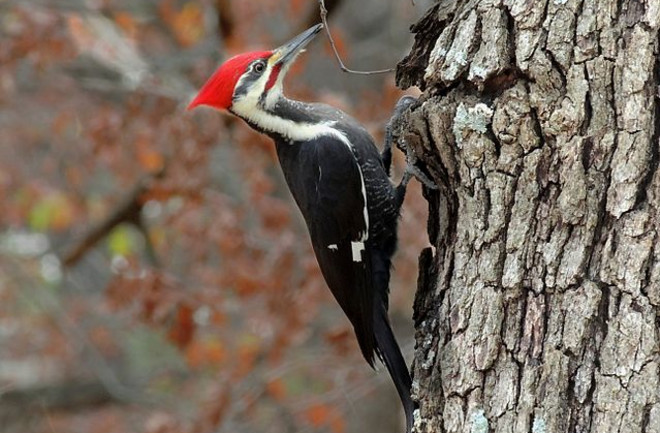"Pileated Woodpecker Feeding onTree" Joshlaymon CC BY-SA 3.0 Wikimedia Commons
Citizen scientists in the bay area are helping conserve birds and their habitats through the San Francisco Bird Bay Observatory. Do you live in the area? Find out more about how you can participate at SciStarter.
Have you ever been interested in bird banding? If so, the San Francisco Bay Bird Observatory (SFBBO) has the citizen science program for you.For over three decades, SFBBO’s mission has been to conserve birds and their habitats through science and outreach. One of our longest-running citizen science programs is our bird banding research at the Coyote Creek Field Station (CCFS) in Milpitas, California.Tucked away from the Bay Area’s urban environment, the field station is situated near three riparian habitat restoration projects on Santa Clara Valley Water District land and is a favorite home and resting spot for many species of birds.Every Wednesday, Saturday, and Sunday morning—year-round—citizen science volunteers in the program work with a staff biologist to capture sparrows, woodpeckers, thrushes, and other resident and migrating passerine landbirds in delicate mist nets.They carry the birds to the field station in soft cloth bags, check the birds’ legs for silver bands, and if a bird does not have a band yet, the volunteers use specialized tools to gently fasten a tiny one to the bird’s leg. They then use scales, rulers, and other measuring and observation tools to collect and record data about the bird’s species type, age, size, and health on data sheets before setting the bird free.Volunteers in the program go through a thorough apprenticeship training process that can take up to three years. During the first phase, volunteers patrol the mist net lanes to make sure predators like raptors or feral cats don’t get to the birds as they hang in the nets. During this phase, participants begin to develop their bird identification skills, become familiar with the tools of the trade, and get to work closely with field biologists.During the second phase of training, volunteers learn how to deftly extract birds from the mist nets and bring them safely to the station for study. This tricky task requires the ability to make careful observations about how a bird has entered the net and what part of the bird is caught, and then undo sometimes intricate knots.In the final phase of training, volunteers learn to use tools like specially-made pliers and viewfinder devices, as well as how to hold a bird securely in the “banders’ grip” while recording data.
A citizen scientist at SFBBO's Coyote Creek Field Station bands a small passerine and collects data on the bird's age, sex, weight, and other characteristics. (Photo by SFBBO) Researchers are required by law to have special permits and training to handle wild birds like this, so volunteering at the Coyote Creek Field Station gives participants a unique opportunity.In addition to the “cool factor” of getting to do avian science in the field, many volunteers also say they appreciate the opportunity to help promote bird conservation and the chance to enjoy nature with like-minded people."I really love volunteering at CCFS because it is like a little oasis in the city,” said Deanna de Castro, a citizen scientist with the program. “It's also really great to be around other people who love birds and studying them as much as I do, and I feel like I learn something new every time I visit!"Thanks to the commitment of ou r long-term volunteers, SFBBO has one of the longest-running data sets on birds in the region. We share our data with the U.S. Geological Survey Bird Banding Laboratory and with students at local universities, who use it to answer questions about bird populations in our area.
Visit SFBBO to learn more or become a volunteer
.
Check out more citizen science projects through the SciStarter Project Finder!





